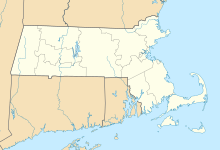Whydah (ship)
|
Model of the ship
|
||||||||||||||
|
||||||||||||||
|
||||||||||||||
|
||||||||||||||
|
||||||||||||||
Coordinates: 41 ° 53 ′ 31.2 " N , 69 ° 57 ′ 33.8" W.
The English ship Whydah [ ˈwɪdɑ ] was built in 1716 as a slave transporter and carried the greatest known pirate treasure of all time under the pirate Sam Bellamy . The Whydah was named after Ouidah , a transshipment point for slaves on the West African coast in today's Benin . The name means "bird of paradise".
history
In February 1717 the slave ship was discovered in the Windward Passage by the pirate fleet of Sam Bellamy. After a three-day chase, Captain Lawrence Prince surrendered it without a fight. The pirates captured precious goods such as rum, cane sugar, molasses, luxury goods, gold and silver worth of 20,000 to 30,000 pounds sterling . Allegedly, among the seized gems was a ruby the size of a chicken egg. The Whydah was still in very good condition, so Bellamy made it his flagship . His crew, called "Robin Hood's Men", soon numbered over 150 men, 30 of whom were slaves who had fled. After the pirates captured the Jamaican frigate Tanner and captured sugar, indigo and silver valued at 5,000 livres , the greatest pirate treasure recorded in history to this day was on board the Whydah . Bellamy had been on the prowl for 18 months before boarding the ship and had no way of unloading his treasures beforehand.
On the night of April 26-27, 1717 a hurricane threw the Whydah onto a sandbar just 150 meters from Cape Cod , the port of destination . Soon after, it sank, only two men surviving. One of them was the 23 year old ship carpenter Thomas Davis. He was brought to court as a pirate, but was able to make credible that he only participated under duress. He was acquitted.
Story of their rediscovery
On July 20, 1984, the American Barry Clifford discovered the first coin of the sunken treasure. Clifford, who grew up listening to the stories of the seafarers in Cape Cod, founded the Whydah Museum after raising around one-sixth of the treasure, with 200,000 exhibits valued between 20 and 40 million US dollars. On July 19, 1998, the hull of the ship was also discovered.
More pirate ship finds
The Whydah is one of only five shipwrecks that have been determined to be a pirate ship. In addition to the Queen Anne's Revenge , the flagship of Blackbeard , which was discovered in 1996 by Mark Wilde-Ramsing, also was Speaker of the pirate John Bowen by historian Patrick Lizé 1980 off the coast of Mauritius discovered. In February 2000, the remains of William Kidd's ship , the Adventure Galley , were discovered off Madagascar. The last found proven pirate wreck is the 1721 decline Fiery Dragon by William Condon , also by Barry Clifford in 2000 in the port of Ile Sainte-Marie ago Madagascar was found.
literature
|
Movie
- Kathryn Taylor: The Pirate's Gold . Documentation of the excavations at the Whydah wreck , United Kingdom 2008, 50 min.
Web links
- Angelika Franz: The Secret of the Dead Pirates Spiegel online from June 25, 2009, accessed on October 25, 2018.
- Museum website
Individual evidence
- ↑ Angelika Franz, Verschollene Freibeuter: The Secret of the Dead Pirates , Spiegel Online from June 25, 2006, accessed on November 12, 2016.
- ↑ page on this at Arte ( Memento from November 3, 2013 in the Internet Archive ). The documentary Das Gold des Piraten combines the story of the Caribbean pirates with a current search for their treasure. Broadcast on May 1 and 2, 2010, accessed on March 15, 2020.


